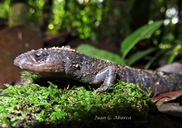|
Bolitoglossa nigrescens (Taylor, 1949)
Black Web-footed Salamander Subgenus: Eladinea | family: Plethodontidae subfamily: Hemidactyliinae genus: Bolitoglossa |
 © 2021 Juan G. Abarca (1 of 3) |
|
|
|
Description Diagnosis: A large, robust black salamander, with moderately extensive digital webbing. Distinguished by the combination of coloring, adult size, degree of webbing, and teeth numbers (Hanken et al. 2005). Similar species: Bolitoglossa nigrescens occurs sympatrically with three other species of the same genus, B. cerroensis, B. pesrubra, and B. sooyorum. It can be distinguished from B. cerroensis by coloration (black venter in B. nigrescens vs. brownish-black mottled with yellow, orange, or cream in B. cerroensis), relatively larger hands and feet (vs. smaller hands and feet in B. cerroensis), more maxillary teeth (vs. fewer in B. cerroensis), and a relatively wider head (vs. narrower in B. cerroensis). It can generally be distinguished from B. pesrubra by coloration; solid black individuals can be distinguished by a more robust form in juvenile B. nigrescens (vs. a more gracile form, longer tail, and narrower body in juvenile B. pesrubra), and larger adult body size (vs. smaller adult size in B. pesrubra). It can be distinguished from B. sooyorum by coloration (solid black in B. nigrescens vs. copper to tan mottling on a rich brown background in B. sooyorum), fewer maxillary teeth (vs. more in B. sooyorum), shorter limbs (vs. longer in B. sooyorum), and narrower hands and feet (vs. broader in B. sooyorum) (Hanken et al. 2005). It can also be distinguished from B. magnifica by the greater number of maxillary and vomerine teeth (fewer in B. magnifica and a relatively more broad head (vs. a relatively narrower head in B. magnifica); from B. robusta by having a uniformly black tail (vs. a light-colored ring at the tail base for B. robusta), smaller size (vs. larger size in B. robusta), smaller limbs (vs. larger in B. robusta), greater number of maxillary and vomerine teeth (vs. fewer in B. robusta); from B. sombra by shorter limbs and a broader head (vs. longer limbs and a narrower head in B. sombra); from B. copia by less extensive webbing and black head and throat (vs. more extensive webbing and white pigment on the jaws, gular region, and throat in B. copia); from B. anthracina by shorter and stouter digits (vs. longer and narrower in B. anthracina), a broader head (vs. narrower in B. anthracina), and fewer maxillary teeth (vs. a greater number of maxillary teeth in B. anthracina) (Hanken et al. 2005). Description: The description is based on three adult specimens. Adult females measure 58.1-94.1 mm in standard length (SVL). TL is shorter than SVL, with a SVL/TL ratio of 1.25. This species has a broad head and truncated snout. Nostrils are small, with weakly developed nasolabial protuberances. Eyes are small but prominent, and extend just past the jaw margins in dorsal view. This salamander has an average of 2.7 (range 1-4) premaxillary teeth, 53.7 (42-73) small maxillary teeth, and 42.7 (26-60) vomerine teeth that are arranged in patches. Limbs are relatively short, with large hands and feet, and the limb interval averages 3.2 (range 2.5-4.0). Digits are plump, bluntly pointed and webbed, except for the 1.5 to 2 distal-most phalanges of longest digits. The fingers in order of decreasing length are 3>2>4>1; toes 3>4>2>5>1. Subterminal pads are prominent on all digits (Hanken et al. 2005). In preservative, Bolitoglossa nigrescens is dark black both dorsally and ventrally. The gular fold and soles of hands and feet are much paler than the surrounding skin. Jaw margins, nasolabial groove, and the ventral side of posterior one-third of tail are slightly paler as well (Hanken et al. 2005). Distribution and Habitat Country distribution from AmphibiaWeb's database: Costa Rica
Life History, Abundance, Activity, and Special Behaviors Trends and Threats Possible reasons for amphibian decline General habitat alteration and loss Comments Populations from the southeastern part of Costa Rica and northwestern Panama were referred to B. sombra and B. magnifica by Hanken et al. (2005). The diagnosis given by Savage (2002) no longer applies (Hanken et al. 2005). A Spanish-language species account can be found at the website of Instituto Nacional de Biodiversidad (INBio).
References
Hanken, J. Wake, D. B., and Savage, J. M. (2005). ''A solution to the large black salamander problem (genus Bolitoglossa) in Costa Rica and Panamá.'' Copeia, 2005(2), 227-245. Savage, J. M. (2002). The Amphibians and Reptiles of Costa Rica:a herpetofauna between two continents, between two seas. University of Chicago Press, Chicago, Illinois, USA and London. Savage, J., Wake, D., Chaves, G., and Bolaños, F. (2008). Bolitoglossa nigrescens. In: IUCN 2010. IUCN Red List of Threatened Species. Version 2010.1. www.iucnredlist.org. Downloaded on 14 May 2010. Originally submitted by: Christine Lu (first posted 2009-11-02) Edited by: Kellie Whittaker (2010-05-13) Species Account Citation: AmphibiaWeb 2010 Bolitoglossa nigrescens: Black Web-footed Salamander <https://amphibiaweb.org/species/3995> University of California, Berkeley, CA, USA. Accessed May 29, 2025.
Feedback or comments about this page.
Citation: AmphibiaWeb. 2025. <https://amphibiaweb.org> University of California, Berkeley, CA, USA. Accessed 29 May 2025. AmphibiaWeb's policy on data use. |



 Raffaëlli Account
Raffaëlli Account Map of Life
Map of Life